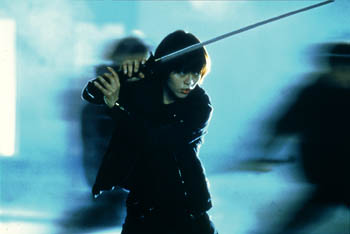From Metroactive.com Buffy The Vampire SlayerSlices of LifeBy Richard von Busack Saturday 13 September 2003, by isa The Japanese sword-wielding epic ’The Princess Blade’ cuts a broad swath
The basic premise: a brave, pretty and slightly dense young girl (Sarah Michelle Geller) is the warrior stationed at the hellmouth, which gapes underneath a mostly Caucasian Southern California suburb named Sunnydale. On the whole, no one in authority seems to care much about the high body count in Sunnydale—one episode mentions the preponderance of unsolved deaths by "neck ruptures" in the town. The trick engineered by the show’s creator, Joss Whedon, was that he interested a younger audience by addressing high school problems of love and loneliness, the feeling that you could die and no one would care. Then, by introducing supernatural elements, he took matters that seem like life and death at the time and turned them into literal matters of life and death. This is why Buffy the Vampire Slayer fascinates an older audience that didn’t just care to watch teenagers cry, as they do on Dawson’s Creek. But the easiest-understood appeal of Buffy must be the action. Everyone likes to see a beautiful woman holding a sword, which is why the Japanese import The Princess Blade can be recommended—again, with reservations. Donnie Yen’s choreography (he did Blade II) engineers impressive samurai-style swordsmanship in modern dress. The story—set in a dystopic future and based on Kazuo Koike’s manga—tells the tale of Yuki (Yumiko Shaku), who breaks away from the Makemikazuchi, a hereditary clan of assassins. On her trail is the clan’s usurper, Byakurai (Kyusaku Shimada, a heavy who has a steam-shovel jaw like Mussolini’s). The violence—by the terms of cinema in 2003, anyhow—is so far over the top that our concept of top is bottom to it. Yuki gets her hand pinned—very slowly and knife-twistingly—by a sword while an evil lesbian named Soma sits over her chest and vilely licks a droplet of blood from Yuki’s Barbara Feldonish lower lip. Our heroine doesn’t take this lying down, naturally, but the timing goes beyond an ordinary satisfying "yeeccch" to a more disquieting "eeeeeeeeeeuuuuww, jezus." One thing the film has going for it is a contrast of looks. Taro Kawazu’s photography creates a fantasy version of Japan cut off from the rest of the world and sunk under a 500-year dictatorship. The details are sketched in well: in the background, we see a statue of the leader of the future, still scaffolded and apparently as big as the Sears Building, amid a row of nuclear reactors or blast furnaces. Touring the city of the future, we hear a voice-over musing, "In the jungle, the safest place to be is on the back of the tiger." Sato contrasts this blight with the early scenes. The assassins live in their perma-frosted Quonset hut in the Oregon-like Kanto area. Yuki and Soma’s long-sword skirmish takes place in some virginal woods in the fog. The problem with The Princess Blade is insufficient action. Urging us to see the human cost of being an assassin, the movie dawdles over Yuki’s recuperation and the young man who protects her (the colorless Hideaki Ito). Telling of the disillusionment of a revolutionary who finds himself not only wanted but sold out, the subplot wanders into a cul-de-sac. Also, pilfered stuff sticks out, such as the bit about the music box wielded by the villain (it came from For a Few Dollars More). Snuffing the assistant villain within the first half-hour doesn’t help. Fortunately, the film finally gets down to business with a sword-filleting that rivals—but doesn’t surpass—the current record holder: the claymore cleaving of Tim Roth in Rob Roy. The real trick, as always, is balancing the human interest to the "girls kicking ass" quotient. Unfortunately, The Princess Blade dawdles over the love story, including a bit about the discovery of a "lucky stone" with symbolic qualities. The mesmerizing spiritual qualities common in Far East action pictures are diluted with sequences that have all the excitement of a New Age crystal lecture. The Princess Blade (R; 92 min.), directed by Shinsuke Sato, written by Kazuo Kamimura, Kazuo Koike, Kei Kunii and Shinsuke Sato, photographed by Taro Kawazu and starring Hideaki Ito, Yumiko Shaku and Kyusaku Shimada, opens Friday at the Towne Theater in San Jose. Send a letter to the editor about this story to letters@metronews.com. |
